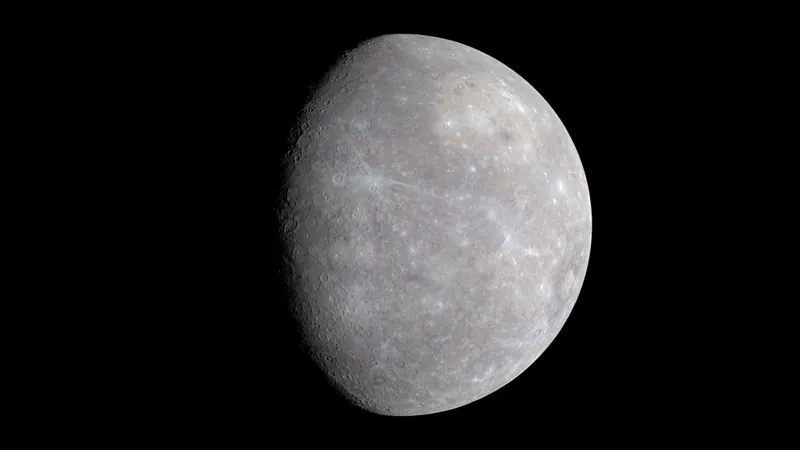
Revolutionary Discovery: Lithium Spotted in Mercury's Exosphere for the First Time!
2025-07-18
Author: Wei
A Groundbreaking Milestone in Space Science
In an astonishing breakthrough, scientists have uncovered lithium in Mercury's exosphere using a pioneering magnetic wave detection technique. This landmark study published in Nature Communications marks the first time this elusive element has been identified in the planet's thin atmosphere.
Peering into Mercury's Mysterious Exosphere
Mercury's exosphere is a fragile realm where gas molecules are few and far between, frequently failing to interact. Despite previous missions like Mariner 10 and MESSENGER since the 1970s providing invaluable data, the presence of lithium had evaded detection. However, studies had confirmed the existence of other alkali metals such as sodium and potassium, spurring speculation that lithium would eventually be found.
A Fresh Approach to Exploration
Led by Daniel Schmid from the Austrian Academy of Sciences, the research team rejuvenated the search for lithium by not directly looking for it, but instead analyzing magnetic field data. They focused on electromagnetic wave signatures known as "pick-up ion cyclotron waves" (ICWs), which indicate fresh ionized lithium in the atmosphere.
"While analyzing MESSENGER's magnetic field data, we captured unique signatures that suggest the presence of newly ionized lithium," Schmid explained to Phys.org. The implications of this finding point toward continuous meteoritic impacts enriching Mercury's surface with volatile elements.
How the Discovery Works: A Dance of Particles
ICWs arise from dynamic interactions on Mercury’s surface. Neutral lithium atoms ascend into space, where they encounter intense solar ultraviolet radiation, stripping away electrons and turning them into charged ions. These charged particles are then swept up by the solar wind, creating electromagnetic waves that resonate at unique frequencies—essentially each element has its electromagnetic fingerprint.
Explosive Origins of Lithium Detections
The rapid and fleeting nature of these detections shine a light on their origins. Rather than slow, gradual processes like thermal heating, the evidence suggested explosive events—specifically, impacts from meteoroids.
When meteoroids slam into Mercury at staggering speeds of around 110 kilometers per second, they generate explosive forces capable of vaporizing rock and ejecting lithium atoms into the atmosphere.
Mercury's Evolution Redefined
This discovery upends previous notions about Mercury's composition. Early theories posited that its closeness to the sun would have baked away volatiles during formation, leaving a desolate landscape. However, the findings from MESSENGER reveal a more complex history where Mercury’s surface was continually enhanced by meteoric impacts over billions of years.
This realization not only reshapes our understanding of Mercury but also opens doors to exploring how other airless bodies in the solar system might acquire volatiles.
A Broader Impact on Solar System Studies
The implications of this research extend beyond just Mercury. As Schmid points out, even celestial bodies like the Moon, Mars, and asteroids may accumulate volatiles post-formation, providing crucial insights into surface chemistry and space weathering across the inner solar system.
This transformative approach reinforces the idea that meteoric events can profoundly shape the evolutionary narrative of rocky planets. The study invites us to rethink the very genesis of our cosmic neighborhood.




 Brasil (PT)
Brasil (PT)
 Canada (EN)
Canada (EN)
 Chile (ES)
Chile (ES)
 Česko (CS)
Česko (CS)
 대한민국 (KO)
대한민국 (KO)
 España (ES)
España (ES)
 France (FR)
France (FR)
 Hong Kong (EN)
Hong Kong (EN)
 Italia (IT)
Italia (IT)
 日本 (JA)
日本 (JA)
 Magyarország (HU)
Magyarország (HU)
 Norge (NO)
Norge (NO)
 Polska (PL)
Polska (PL)
 Schweiz (DE)
Schweiz (DE)
 Singapore (EN)
Singapore (EN)
 Sverige (SV)
Sverige (SV)
 Suomi (FI)
Suomi (FI)
 Türkiye (TR)
Türkiye (TR)
 الإمارات العربية المتحدة (AR)
الإمارات العربية المتحدة (AR)